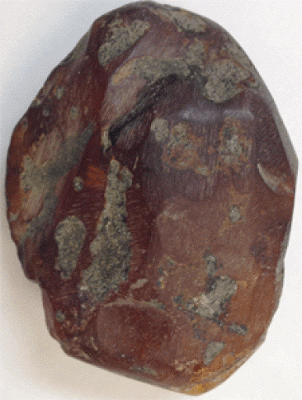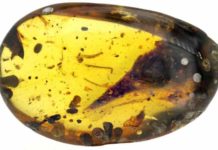
Along the way, the investigation sheds light on the long-held urban myth of the fluidity of stained glass.
In some circles, no matter how much experimentation and research is done that gives a definitive answer to the contrary, some urban myths continue to live.
Even in the scientific community some urban legends never seem to go away. One of those involves whether glass flows over time, using the example of stained-glass windows in medieval cathedrals as an example where the glass pieces appear thicker at the bottom. The thinking is the glass flowed downward over centuries.
A pair of Texas Tech University professors and a doctoral student, however, recently used prehistoric amber to test theories of glasses and concurrently provided new information to dispel that myth. Their findings were highlighted by the National Science Foundation (NSF), which funded the research.
The study by Greg McKenna, Horn Professor and the John R. Bradford Chair in the Department of Chemical Engineering, Sindee Simon, Horn Professor and chemical engineering department chair; and Jing Zhao, a chemical engineering doctoral student, tested the thermal, mechanical and flow properties of 20 million-year-old Dominican amber glass.
What they found was the density of the amber after 20 million years of aging is just roughly 2 percent more than the same amber that had been heated past its glass transition temperature and then rapidly cooled, a process referred to as thermal rejuvenation. In the first heating, they determined the fictive temperature of the amber to be about 44 degrees Celsius lower than the glass transition temperature, an important piece of their study.
McKenna and his colleagues showed the molecular mobility of the amber in the temperature window between the fictive temperature and the glass transition temperature does not diverge as suggested by classical glass theory. In addition, McKenna commented the extremely long time to get a 2 percent density change in the amber at a temperature only 110 degrees Celsius below the glass transition temperature shows that the glass in windows that are 900-1,200 years old and multiple hundreds of degrees Celsius below the glass transition would certainly not have noticeably changed in that time frame, thus dispelling the myth of glass flowing far below its glass transition temperature.
“It’s a cute story,” McKenna said. “If you do the calculations you can show that it’s really not true. But it makes it exciting to show that the time scale involved in this process is way too long for cathedral glass to be flowing.”
Necessary time
The impetus for the experiment began, McKenna said, after Zhao carried out experiments for her doctorate qualifying exam where a polyvinyl acetate polymer was aged 22 days at about 14 degrees Celsius below the glass temperature. That’s a long time in the life of a graduate or doctoral student but not long enough to answer fundamental questions regarding glass transition temperature.
McKenna said for common window glass, the glass transition temperature is more than 1,000 degrees Celsius, while for many polymer glasses it is about 100 degrees Celsius. Even in high-performance polymers it may be below 250 degrees Celsius. McKenna said it is important to understand that range of temperatures and the glass theories that he and his colleagues were testing form the current basis for making long-term predictions about materials such as polymeric adhesives or polymer resin-based composites that are used in products such as passenger jet airplanes.
McKenna, Simon and Zhao, however, wanted to take the experiment beyond the 220 days, so McKenna was able to find a reliable source for Dominican amber through the Dead Bug in Amber Club, and Zhao “took the amber and ran with it,” McKenna said.
Through heating the material and cooling it either rapidly or gradually, the researchers discovered that, in the course of 20 million years, the reduction in glass transition temperature to fictive temperature was only about 45 degrees, a relatively slow change considering the age of the material.
“For us, that window is important because previously, it was only about 15 degrees in 22 days,” McKenna said. “To go from 22 days to 20 million years and only get an extra 30 degrees, it shows how slow things move in glass forming materials once they are below the glass transition temperature. Then we were able to establish with the amber in that window that the paradigm of diverging time scales above absolute zero didn’t seem to be true, and that’s what we were looking to test.
“By working between fictive temperature and the glass transition temperature we’re able to say the upper-bound behavior is not close to the extrapolated models.”
The myth lives
McKenna points to a 1995 comment in the journal Science on the nature of glass by Phillip Anderson, who won the Nobel Prize in Physics in 1977, as a reason why research continues in this area. Anderson said, “The deepest and most interesting unsolved problem in solid state theory is probably the theory of the nature of glass and the glass transition.”
McKenna said many theories arising from the research tend to be those of the behavior of glass above the glass transition temperature when the material is in equilibrium. The problem, he said, is that below glass transition temperature, the material falls out of equilibrium.
“It is these really long time scales that are needed to get it back into equilibrium,” McKenna said. “Scientists want to know if, below the glass transition, is the behavior as predicted by theory? And we’ve found there is a whole class of theory that does not agree with what has been found. And, in my opinion, that class of theory should be abandoned because it is incorrect and you will never be able to correctly predict below glass transition behavior using such theories. New theories are being developed in laboratories, and the amber data are good enough that we can actually discriminate among these theories.”
McKenna said a group of scientists at the University of Wisconsin has developed a way to create 10 million-year-old glass in 10 minutes through a method called physical vapor deposition, and this may provide researchers a way to conduct more thorough examinations of glass dynamics. McKenna also is planning to test theories using metallic glass.
The ultimate goal is to make long-term predictions on the behavior of materials in the glassy state and how those materials can be used. Examples range from the new Airbus A-380 or the Boeing 787 Dreamliner place that make broad use of composite materials that are made with glassy organic resins and polymers that will age over the lifespan of the aircraft.
“Understanding that aging will also affect our understanding and ability to predict when they will break,” McKenna said. “We think it’s important. For example, I was just at a workshop last year at the NSF where scientists from universities and industry got together to look at lifetime issues. The reality is there’s a whole group of people who say the same thing, that we don’t know enough about the behavior of these materials in the glassy state to make reliable long-term predictions.”
Note : The above story is based on materials provided by Texas Tech University.










